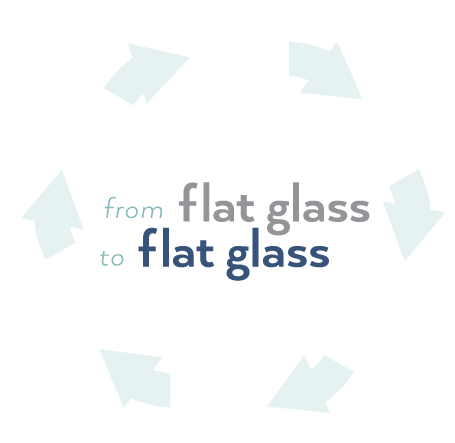Recycling of end-of-life building glass
Glass for Europe’s contribution
The increased attention paid to resource efficiency, sustainable use of natural resources and sustainable buildings has raised awareness of the potential of the building sector to contribute to Europe’s goals in these areas.
The Resource Efficiency Roadmap[1] identifies the building sector as one of the sectors that is key to addressing the challenges of energy, climate change and resource efficiency. The Roadmap recognises that increased waste recycling, among other measures, will contribute to a competitive construction sector. This objective is also in line with the new basic requirement set out in the Construction Products Regulation concerning sustainable use of natural resources, as well as with the Raw Materials Initiative (RMI). Development of best practices in the collection and treatment of waste, recovery/reuse of valuable materials from waste and research and economic incentives for recycling/recovery should be supported[2].
Flat glass is an important material in buildings, and can help achieve these goals, provided that end-of-life management is improved. Moreover, the flat glass industry is willing and keen to increase the quantity of recycled glass in its production processes. Expanding the availability of high quality recycled cullet will reduce both waste going to landfill and the use of virgin raw materials[3]. It can therefore contribute to the EU sustainability and low carbon agendas while strengthening the competitiveness of EU-based industries.
Glass for Europe and flat glass manufacturers wish to promote the dismantling, collection and recycling of end-of-life building glass (from windows, glazing and other products) and to ensure that end-of-life flat glass does not end up in landfill.
1. Executive summary
Current situation
Despite its recyclability, end-of-life building glass is almost never recycled into new glass products. Instead it is often crushed together with other building materials and put into landfills or recovered.
Most of the flat glass used in buildings could be dismantled and recycled in glass furnaces. The flat glass industry is eager to support the development of end-of-life building glass collection, sorting and recycling and is ready to use more recycled glass in its manufacturing process, and therefore save raw materials, energy and CO2 emissions.
The absence of an in-depth European study on this issue has resulted in a shortfall of reliable data on quantities of end-of-life building glass and current practices across Europe on sorting, collection and recycling. Such a study is needed as a first step in order to apprehend the scale of the challenge and in order to identify best practices.
Many different steps need to be taken before waste glass can be recycled by the glass industry. The biggest challenges are linked to the creation of recycling schemes able to ensure and organise the dismantling of windows or glazing from buildings before demolition, the collection of these windows or glazing after building demolition or renovation, and the segregation of glass from other window components before recycling in a glass furnace.
Development of collection and recycling schemes
The development of systems to collect and recycle building glass must take the following principles into account:
► The need to find the right balance between EU and national measures and initiatives. Whereas EU legislation can be supportive, solutions need to be adapted to local realities.
► Priority must be given to closed loop recycling, as there is still room to increase the percentage of recycled flat glass used in the flat glass manufacturing process.
► Financial support should be adequate. Initial financing will be needed to trigger action and create/ set up the infrastructure and management schemes.
Activation of EU instruments and policy measures
Glass for Europe believes that several EU regulatory instruments and initiatives will need to be activated in a coordinated manner in order to achieve results.
► The Waste Framework Directive recommends that recycling targets and national waste management plans should be reviewed. Individual targets on specific types of waste (such as building glass), mandatory provisions for auditing, dismantling and sorting the glass, before demolition or renovation of tertiary buildings, are measures that should be considered.
► The disposal to landfill of recyclable flat glass products should be banned, in the case of glass that can fulfil the end of waste criteria, after economically viable treatment.
► The legislation should be complemented by EU guidance with technical recommendations for MS on collection, sorting and recycling of end-of-life flat glass across Europe.
► The deployment of new technologies should be supported by existing initiatives at EU level both on the processing and product sides.
2. Current situation of end-of-life building flat glass
This paper only addresses glass in demolition waste. During the construction phase of a building, there is very little glass waste generated since glass products are already delivered in their final size.
According to the staff working document accompanying the Commission’s report on the Thematic Strategy on the Prevention and Recycling of Waste, the estimates of C&D waste generated range from 510 million tonnes to 970 million tonnes per year[4]. Even if glass represents about 0.66% of C&D waste[5], the quantities of end-of-life glass generated from this source are not negligible.
Most of the glazing already placed in buildings could be dismantled and recycled in glass furnaces with no technical issues. Some local solutions to enable recycling already exist, however they remain experimental and very marginal.
Despite its recyclability, end-of-life building glass is almost never recycled into new glass products. Instead it is very often crushed together with the other building materials and put into landfills or recovered together with other C&D waste. This is facilitated by its inert characteristics. It currently has a low market value because there is a lack of properly organised collection and recycling systems to generate what would be a valuable glass-making raw material.
When tackling this issue, one of the complexities that need to be taken into account is the variety of building glass and building types. Glazing in buildings comes in many forms depending on the building type, the frame materials used, the installation period, locations (construction code), etc. In general, recovered building glass can be grouped into three categories:
► Glazing from large tertiary building (facades)
► Glazing from residential collective buildings and individual houses’ windows
► Glass used for interior applications (balustrades, glass walls, mirrors, etc.)
The broad range of buildings and glass types and the fact that glass is usually part of a framed window and not a ‘stand alone’ product makes a collection scheme complex. All these aspects must be looked at when considering collecting, sorting, treating and ultimately recycling glass.
Glass for Europe believes that collection and recycling of end-of-life glazing could represent a valuable business opportunity to be developed across Europe, if Member States promote the idea and help to develop collection and treatment schemes.
The starting point of any reflection on this issue should be an in-depth analysis of today’s situation, taking into account the variety of glass uses in buildings in the different Member States.
3. Current situation of regulatory context
The Waste Framework Directive (Directive 2008/98/EC) establishes specific targets for the reuse and recycling of building waste including glass[6] and aims to place recycling and a high level of resource efficiency at the heart of European society.
The 70% target for reuse and recycling applies to C&D waste in general. However, as glass represents less than 1% of C&D waste, this target does not serve as an incentive to set up flat glass collection schemes. Moreover, in theory this target could be achieved with 0% of glass being recycled.
The Landfill Directive (Directive 1999/31/EC) can also be seen as a milestone in EU waste policy. It is regarded as driving the shift from landfill to the EU’s waste hierarchy[7]. However, the Directive does not present any specific glass measures. As an inert material, it is easy and relatively cheap to send glass to landfills, which does not favour the emergence of glass recycling.
Under the WFD, the Commission Regulation 1179/2012 establishing criteria determining when glass cullet ceases to be waste (end-of-waste) was published in December 2012. According to this Regulation end-of-waste status can be attributed to flat glass materials. This is recognition of the existing opportunity for glass materials to be recycled and should be seen as facilitating recycling. The flat glass industry welcomes this Regulation, but believes that as an isolated measure it is not enough to promote collection and recycling of C&D glass.
The current regulatory framework does not provide incentives for the recycling of C&D glass. Glass for Europe therefore believes that there is a need to revise the EU policy instruments in order to promote the collection and recycling of building glass.
In recent months, several initiatives have been launched at European level in connection to recycling building glass. Glass for Europe and its member companies are willing to engage with the Commission and provide their contribution to the various ongoing and upcoming initiatives and debates. In particular we will participate and contribute to the thematic group on Sustainable Use of Natural Resources (Sustainable Competitiveness of the Construction Sector Forum), the European Innovation Partnership of Raw Materials and the Sustainable Buildings Initiative.
The industry is willing to engage in the different initiatives and also to participate in the review of EU waste framework legislation.
4. What could be the ‘recovery and recycling’ route?
Flat glass manufacturers are willing to collaborate in the promotion and development of effective collection and recycling schemes for end-of-life building flat glass. With their expertise, they can play an important role as advisors in the process.
1. Dismantling of the window, glazing or other flat glass products from the building
Dismantling of the window, glazing or other flat glass products from a building is the first key step towards achieving the highest recycling rates of building glass.
2. Collection of the dismantled window, glazing or other flat glass products
Once the glazing and/or windows are dismantled from the building, proper sorting and collection at the earliest stage possible is essential to avoid the breakage and potential contamination of the glass by other building components (such as vitroceramics, bricks, wood, etc.) that would make efficient recycling more difficult.
In the case of tertiary buildings, it is preferable for glass containers and/or collection points to be made available on site in order to allow efficient sorting and collection during demolition.
In the case of window replacements in residential housing, easily accessible collections points should be made available throughout the country. Collection could be organised by central government/ municipalities, industry waste parks or construction products distribution centres.
3. Segregation of the glass from the window
Once the glazing and/or windows are properly sorted and collected, the next step is the separation of the glass from the window. Some techniques to separate the glass from other window components (window frames, hinges, sealants, insulation materials, etc.) are available, but need to be improved and become more widespread. The separation can be done either on-site or elsewhere, depending on the quantities, and on the availability of techniques and equipment. At this stage, glass is often mixed with residues of window frames, (sealants, spacers, etc.) and does not fulfil the end-of-waste criteria.
4. Treatment to remove pollutants from glass
The next step is to remove impurities from the glass. The treatment by specialist external glass recyclers is needed in order to ensure the cullet quality required for recycling into new glass products.
At this stage, the glass cullet should comply with the end-of-waste criteria and be able to be recycled in glass furnaces.
5. Recycling in flat glass furnaces
After proper treatment, the cullet should be able to fulfil the highest quality specifications, as required by flat glass manufacturers, and can be sent back to the glass furnaces to produce new flat glass products (closed loop recycling).
6. Logistics
To create an efficient and economically acceptable scheme, logistics are of fundamental importance across Europe. Logistic networks need to be in place for the different stages on the recycling process, i.e. from the building site to the glass furnaces (in the case of closed loop recycling). Adaptable supply chains are a key point for cost optimisation and reduction of environmental footprint.
5. What could be the principles for policy intervention?
► Find the right balance between EU and national measures to best fit local implementation
In Glass for Europe’s opinion improving the recycling of different building materials requires measures to be taken at both the European and national level. The main policy signals, such as targets and other mandatory measures, need to be set at European level. However, a certain degree of flexibility must be left to Member States to establish and implement their own national and/or local measures and to support the development of recycling schemes that are effective and workable. In the case of flat glass, much work has to be done since there are currently no structured solutions that enable effective collection and recycling of glass from demolition waste. The Netherlands is a notable exception since a flat glass collection and recycling scheme is already in place (VNR system).
EU legislation and EU targets on recycling should be set in order to boost the development of collection schemes at country level, which need to be adapted to specific national and local situations.
► Give priority to closed loop recycling
Glass manufacturers are ready to take back waste flat glass to be recycled into new flat glass products, provided quality specifications are met. Flat glass manufacturers agree on and support the principle of closed loop recycling to increase the recycled content of flat glass products, as there is still room to increase the percentage of recycled glass used in the manufacturing process.
Building glass cullet that cannot be recycled technically and cost effectively in the flat glass sector could be recycled in other sectors of the glass industries, such as in the container and fibre glass sectors.
► Provide adequate financial support
Glass for Europe believes that a collection and recycling system needs to be supported as rapidly as possible. This will require investments to trigger action, and create the infrastructure and management scheme. However, once the system is running, the market demand and cullet price should drive the market and the system should ideally become self-financing.
The initial financing of the scheme cannot be borne by the industry alone. Industry is already committed to paying the market price to take back usable cullet. Therefore public funding, or some other source of finance, could be needed to support a new and extensive recovery and recycling system.
6. Which EU instruments and policy measures are needed?
Glass for Europe believes that several European instruments should be considered and coordinated in order to achieve the best results. It should nevertheless be kept in mind that these measures, in particular at European level, should drive competitiveness and these should not result in additional costs incurred by the industry.
► The Waste Framework Directive/recycling targets and national waste management plans should be reviewed
The Waste Framework Directive already sets requirements for Member States to establish a waste management plan addressing, among other aspects, an assessment of the need for new collection schemes (Article 28). It also sets a target of 70% for reuse and recycling of building waste materials, including glass.
Glass for Europe takes the view that the current targets on building waste materials do not provide enough ambition to recycle glass because glass represents less than 5% of the C&D waste. Therefore Glass for Europe is of the opinion that, when revising the targets on C&D waste[8], individual targets on specific types of waste (such as glass) should be set, in line with the global target on C&D waste. This should lead to increased dismantling, sorting and collection of glazing and/or windows from buildings. Otherwise, provisions to dismantle and sort the glass should be made mandatory.
Audits before demolition or renovation of tertiary buildings are another measure that Glass for Europe believes could significantly boost recycling. Audits should lead to recommendations and obligations as to the sorting and recycling of glass material per type of glass (e.g. clear, laminated, reinforced, enamelled, etc.), where this is feasible and cost effective. These type of audits are already required in France[9] and in the United Kingdom as part of the granting of demolition permits.
► The disposal of recyclable flat glass products in landfills should be banned
Glass that can fulfil the end-of-waste criteria, after economically viable treatment, should be banned from landfill.
The majority of C&D waste flat glass is currently not recycled in any glass furnace and goes to landfill, despite the fact that a significant proportion could be easily treated and recycled. Often, landfill costs are cheaper than treating C&D glass, particularly in countries with low landfill taxes/fees in place. Several measures and/or combination of measures, at European and national level, such as recycling targets for specific waste building products and collection schemes, should be implemented to minimise the amount of glass going to landfill.
► The legislation should be complemented by EU Guidelines on the recycling of end-of-life flat glass products from buildings
Glass for Europe also suggests that in addition to the legislation, EU guidance is drafted with technical recommendations for MS on collection, sorting and recycling of end-of-life flat glass across Europe. For example, these guidance documents could describe available technical solutions for dismantling glazing and/or windows, separating glass from window frames and treating glass cullet.
Member States and construction stakeholders should facilitate the transfer of experience and best practice about dismantling and recycling of old glazing, to improve the culture and achieve full operational implementation across construction businesses.
► Technology deployment should be supported
The deployment of new technologies that step up dismantling of glazing and/or windows from the building, segregation of different window components and treatment should be promoted.
Insulated glass units (IGU’s) that are easier to dismantle from the window are the current state of the art technology, but new deployments should be supported by existing initiatives at EU level both on the processing and product sides.
Conclusion
Glass for Europe believes that before implementing any measure it is of fundamental importance to have a clear understanding of the current situation in the different Member States with regard to collection and recycling rates, amounts of glass currently sent to landfill and other “uses”, different requirements and measures in place for waste flat glass, etc.
The current heterogeneity amongst Member States on how indicators on recycling, recovery & collection rates are defined and quantified make comparison difficult and do not allow for a clear and accurate picture of recycling across Europe.
Glass for Europe is eager to engage constructively with EU authorities in order to set an overall EU framework that will allow the development of dismantling, collection and recycling schemes for demolition glass across Europe.
[1] COM(2011)571 final- Roadmap to a Resource Efficient Europe, 20.9.2011.
[2] COM (2012) 433 – Strategy for the Sustainable Competitiveness of the Construction sector and its Enterprises (SWD(2012) 236)
[3] In the flat glass industry, the use of one tonne of recycled glass, named “cullet”, saves 1.2 tonnes of raw materials and 0.3 tonnes of CO2. It therefore not only helps to save natural resources, but also contributes to reducing energy consumption and CO2 emissions from manufacturing sites.
[4] COM(2011) 13 final: Thematic Strategy on the Prevention & Recycling of Waste/ Commission staff working document. According to Eurostat there was around 330 million tonnes C & D waste generated in 2010.
[5] Study on external environmental effects related to the life cycle of products and services. European Commission, DG Environment. 2003.
[6] Two specific targets are set under Article 11.2:
(a) by 2020, the preparing for re-use and the recycling of waste materials such as at least paper, metal, plastic and glass from households and possibly from other origins as far as these waste streams are similar to waste from households, shall be increased to a minimum of overall 50 % by weight;
(b) by 2020, the preparing for re-use, recycling and other material recovery, including backfilling operations using waste to substitute other materials, of non-hazardous construction and demolition waste excluding naturally occurring material defined in category 17 05 04 in the list of waste shall be increased to a minimum of 70 % by weight.
[7] The European Environment Agency states in its report 7/2009[7], that the Landfill Directive has been a driver for a shift from landfill towards the EU’s waste hierarchy and seeks to avoid landfilling wherever feasible. This is true for municipal waste, but is likely to be true as well for other waste streams such as construction and demolition waste. But there are clear differences between countries.
[8] The Directive foresees, under article 11.4, these targets to be examined and reinforced, if necessary, by 31 December 2014.
[9] French decret 2011-610 du 31 mai 2011 relatif au “diagnostic portant sur la gestion des déchets issus de la démolition de categories de bâtiments.
















